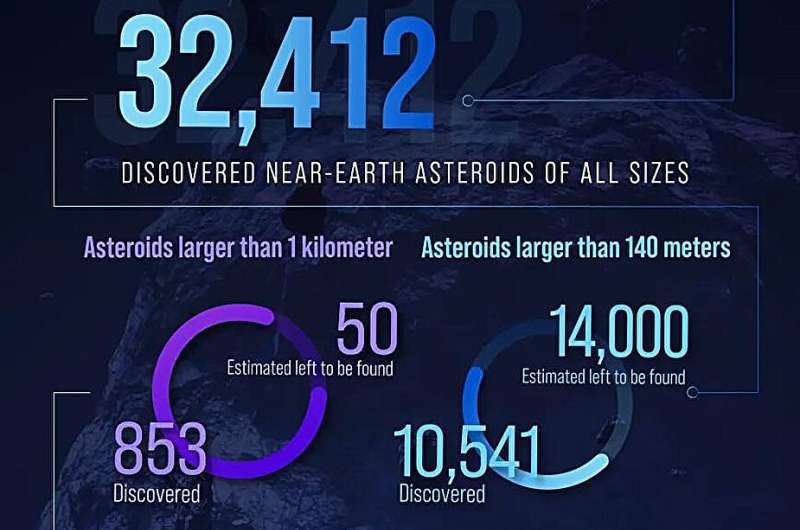This article has been reviewed according to Science X's editorial process and policies. Editors have highlighted the following attributes while ensuring the content's credibility:
fact-checked
trusted source
proofread
There are 14,000 potentially hazardous city-killing asteroids left to find

Everyone likes a cool infographic, right? Does that statement hold even if the infographic points out a gap in our knowledge that could kill millions of people? Because that's what a cool-looking infographic NASA released on October 16th does.
One of NASA's more practical tasks is commonly known as "Planetary Defense"—basically, it's keeping an eye out for asteroids that could potentially hit the Earth and cause widespread devastation. Most people have heard about what happened to dinosaurs. NASA's planetary defense side wants to ensure it doesn't happen to us.
That's easier said than done. Asteroids don't emit any of their own light, so usually, the only way to detect them is when sunlight reflects off their surface down to one of the various telescopes watching the night sky. Lately, there have been more and more of them that are specially designed to be asteroid hunters.
Those new telescopes have been doing work—the infographic points out that, as of the end of August 2023, there are 32,000 known Near-Earth asteroids. The effort to find and track them has been even more impressive—more than 405 million observations from amateur and professional astronomers alike have been submitted to the Minor Planet Center, one of the central hubs of NASA's planetary defense strategy and a central clearinghouse for asteroid hunters all over the globe.
Now for the disturbing parts—of those 32,000 near-Earth asteroids, more than 10,000 are more than 140 m in diameter. By most common estimates, if one of those were to hit the Earth, it would be capable of wiping out an entire city. In comparison—the asteroid that hit the Chelyabinsk district of Russia back in 2013, shattering windows and injuring almost 1,500 people, was estimated to be at most 20 meters.
An asteroid seven times that size would be much more devastating and likely hit the ground. In contrast, the Chelyabinsk meteor disintegrated in an air burst before it got there. Placed in the right spot, such an asteroid could easily wipe out a city and, depending on where it came down, could potentially kill millions of people.
As of now, we aren't aware of any of those 10,000 140-meter-wide asteroids that are on a collision course with Earth. But another number in the infographic is probably the most terrifying—NASA's planetary defense experts think we haven't even found half of the near-Earth asteroids of this size.
They estimate there are more than 14,000 140m-diameter asteroids that we have yet to find. And one of those could well be on a collision path. Even more strikingly, they estimate that there are around 50 1km-diameter asteroids that we have yet to find floating in the void of space. An asteroid that size could be catastrophic to civilization on a scale far larger than a single city, though still not quite on the scale of the impact that did for the dinosaurs, estimated to be about 10 kilometers in diameter.
The planetary defense community, which includes a slew of other organizations—not just NASA, has a lot more work to do to ensure the safety of humankind if these estimates are correct. But every little bit helps—even infographics that simply convey information can potentially inspire someone to join the hunt. We need all the help we can get.
Provided by Universe Today



















